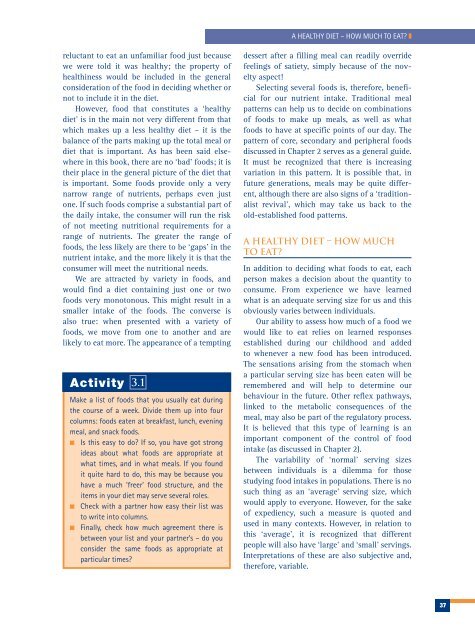Human Nutrition
Human Nutrition
Human Nutrition
Create successful ePaper yourself
Turn your PDF publications into a flip-book with our unique Google optimized e-Paper software.
A HEALTHY DIET – HOW MUCH TO EAT? ❚<br />
reluctant to eat an unfamiliar food just because<br />
we were told it was healthy; the property of<br />
healthiness would be included in the general<br />
consideration of the food in deciding whether or<br />
not to include it in the diet.<br />
However, food that constitutes a ‘healthy<br />
diet’ is in the main not very different from that<br />
which makes up a less healthy diet – it is the<br />
balance of the parts making up the total meal or<br />
diet that is important. As has been said elsewhere<br />
in this book, there are no ‘bad’ foods; it is<br />
their place in the general picture of the diet that<br />
is important. Some foods provide only a very<br />
narrow range of nutrients, perhaps even just<br />
one. If such foods comprise a substantial part of<br />
the daily intake, the consumer will run the risk<br />
of not meeting nutritional requirements for a<br />
range of nutrients. The greater the range of<br />
foods, the less likely are there to be ‘gaps’ in the<br />
nutrient intake, and the more likely it is that the<br />
consumer will meet the nutritional needs.<br />
We are attracted by variety in foods, and<br />
would find a diet containing just one or two<br />
foods very monotonous. This might result in a<br />
smaller intake of the foods. The converse is<br />
also true: when presented with a variety of<br />
foods, we move from one to another and are<br />
likely to eat more. The appearance of a tempting<br />
Activity 3.1<br />
Make a list of foods that you usually eat during<br />
the course of a week. Divide them up into four<br />
columns: foods eaten at breakfast, lunch, evening<br />
meal, and snack foods.<br />
■ Is this easy to do? If so, you have got strong<br />
ideas about what foods are appropriate at<br />
what times, and in what meals. If you found<br />
it quite hard to do, this may be because you<br />
have a much ‘freer’ food structure, and the<br />
items in your diet may serve several roles.<br />
■ Check with a partner how easy their list was<br />
to write into columns.<br />
■ Finally, check how much agreement there is<br />
between your list and your partner’s – do you<br />
consider the same foods as appropriate at<br />
particular times?<br />
dessert after a filling meal can readily override<br />
feelings of satiety, simply because of the novelty<br />
aspect!<br />
Selecting several foods is, therefore, beneficial<br />
for our nutrient intake. Traditional meal<br />
patterns can help us to decide on combinations<br />
of foods to make up meals, as well as what<br />
foods to have at specific points of our day. The<br />
pattern of core, secondary and peripheral foods<br />
discussed in Chapter 2 serves as a general guide.<br />
It must be recognized that there is increasing<br />
variation in this pattern. It is possible that, in<br />
future generations, meals may be quite different,<br />
although there are also signs of a ‘traditionalist<br />
revival’, which may take us back to the<br />
old-established food patterns.<br />
A healthy diet – how much<br />
to eat?<br />
In addition to deciding what foods to eat, each<br />
person makes a decision about the quantity to<br />
consume. From experience we have learned<br />
what is an adequate serving size for us and this<br />
obviously varies between individuals.<br />
Our ability to assess how much of a food we<br />
would like to eat relies on learned responses<br />
established during our childhood and added<br />
to whenever a new food has been introduced.<br />
The sensations arising from the stomach when<br />
a particular serving size has been eaten will be<br />
remembered and will help to determine our<br />
behaviour in the future. Other reflex pathways,<br />
linked to the metabolic consequences of the<br />
meal, may also be part of the regulatory process.<br />
It is believed that this type of learning is an<br />
important component of the control of food<br />
intake (as discussed in Chapter 2).<br />
The variability of ‘normal’ serving sizes<br />
between individuals is a dilemma for those<br />
studying food intakes in populations. There is no<br />
such thing as an ‘average’ serving size, which<br />
would apply to everyone. However, for the sake<br />
of expediency, such a measure is quoted and<br />
used in many contexts. However, in relation to<br />
this ‘average’, it is recognized that different<br />
people will also have ‘large’ and ‘small’ servings.<br />
Interpretations of these are also subjective and,<br />
therefore, variable.<br />
37

















